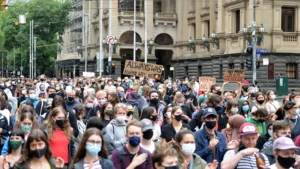Home » Commentary » Opinion » The problems facing remote Indigenous communities can’t be boiled down to white racism alone
· Canberra Times
 A lot of attention is being shifted to Indigenous politics in light of Labor’s commitment to holding a referendum on Constitutional recognition.
A lot of attention is being shifted to Indigenous politics in light of Labor’s commitment to holding a referendum on Constitutional recognition.
While it would be going too far to suggest this has led to other important problems in Indigenous affairs being ignored, it would be a mistake for Voice advocates to simplistically imply it will solve all these problems.
One such problem is domestic violence, which my former colleague — now Senator-elect — Jacinta Price has done an excellent job of highlighting. Of particular concern is the lack of support within the community for Indigenous women and children who are victims of violence.
Another related area is Indigenous incarceration, where it is implied that the primary issue is racism within the criminal justice system. In reality, the situation is far more complicated, involving the intersection of policing, poverty, poor education, childhood trauma, and a lack of positive opportunities and role models.
Failure to accept and adapt to this complexity, and to rigorously evaluate government intervention, are the biggest problems plaguing attempts to close these gaps.
Perhaps the most obvious example of such failure is in Indigenous health. Despite the investment of enormous sums of money, and more than a decade of focus on closing the gap in areas such as life expectancy, Indigenous Australians remain well behind the rest of the country.
In a recent CIS paper, former Royal Melbourne Hospital director of chemical pathology, Dr Richard X Davey, identified several key root causes of this gap. In particular, he pointed at high rates of smoking in Indigenous communities, low birthweights, poor diet, misuse of alcohol (especially during pregnancy) and teenage pregnancy as major risk factors worth examining in more detail.
In the Northern Territory for example, more than 40% of first time Indigenous mothers are under the age of 20, compared with just 3% of non-indigenous mothers. Almost 20% of first time Indigenous mothers are under the age of 18. This is a significant risk factor for premature delivery and low birthweight.
These factors can have life-long negative consequences, which are exacerbated by smoking and drinking during pregnancy.
In the Northern Territory, Indigenous infants were more than 3 times likely to be low birthweight, while the ratio was also above 2.5 in Western Australia. In 2017, more than 10% of Indigenous infants born in the Northern Territory, Western Australia, South Australia, Victoria and Queensland were low birthweight.
Various studies have looked into the prevalence of maternal smoking and its effect on low birthweight. Although the proportion of Indigenous mothers who reporting smoking during their pregnancy decreased by around 6% over time, the percentage remains approximately 4 times as high as non-indigenous mothers.
Importantly, more than 54% of very remote Indigenous mothers, and almost 49% of remote Indigenous mothers, reported smoking during pregnancy in 2019. Given the large disparity between outcomes for Indigenous people in cities and those in remote communities, it is not clear that the same level of progress is happening in the areas where people are really struggling.
Estimates suggest that 47% of Indigenous babies with low birthweight between 2015-17, and 37% born between 2017-19, were attributable to smoking during pregnancy.
Of course, as my former colleague Sara Hudson noted in her 2017 report, there are a plethora of Indigenous anti-smoking campaigns. The biggest problem is that many of these programs are never reviewed or evaluated for effectiveness, a theme repeated throughout this area of policy.
As Dr Davey argued, teenage pregnancy and use of tobacco and alcohol (both maternal use and by individuals) are key causes of many of the poor health outcomes for Indigenous Australians across their lifetime.
Though some are quick to blame racism for any difference in outcomes between Indigenous and non-indigenous Australians, it is hard to see these poor choices as being solely the product of white racism.
A better, but far more complex, explanation is poverty. An Australian Institute of Health and Welfare report from 2014 suggested that mothers in more disadvantaged socioeconomic conditions were more likely to have low birthweight babies.
Indigenous Australians in remote and very remote communities are among some of the most impoverished people in the country.
But the solution to enduring poverty in remote Indigenous communities isn’t about higher rates of welfare. Indeed, there is an argument to be made that poverty is itself caused by deeper factors like a general lack of economic activity in the community, deficiencies in education and the perceived (or real) absence of a genuine path to a happy and productive life.
When young people don’t see how they can get ahead, they often make poor choices. Without even the basics of a good education, and when many of adults in the community don’t have a job or abuse alcohol and drugs, the odds are stacked against many young people in remote communities.
The dysfunction in these communities has not been caused by an absence of government attention; if anything, the government has been more focused on these communities than many others. The issue seems to be one of accountability: everyone wants more control over the money but no-one is taking responsibility for the results.
It is hard to see how simplistic messages about racism or representation will encourage the honest evaluation and analysis of outcomes that are truly needed. The fear is that they are more likely to obscure them further.
The problems facing remote Indigenous communities can’t be boiled down to white racism alone